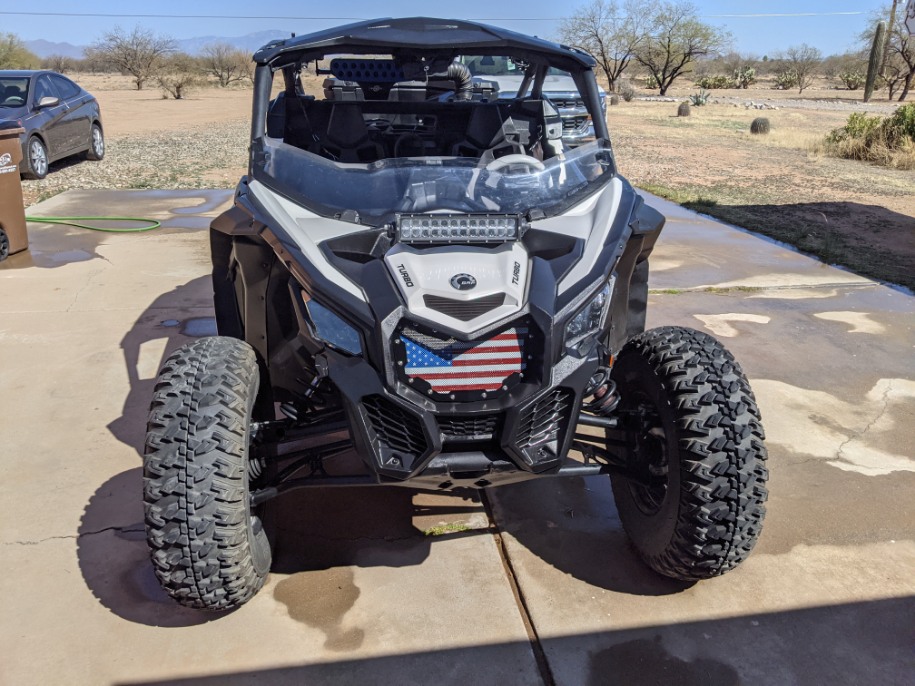
Can-Am Maverick (2022 Review)
Thinking about buying a Can-Am Maverick? Read our expert review to get a better idea of why the Can-Am Maverick is one of the most coveted side-by-sides in motorsports.
Can-Am Side-by-sides are some of the favorites for racing in the Baja, rock crawling in Moab, and cruising on dirt roads for miles. Even Pastranaland has a track for jumping these around!
The 3-cylinder Rotax Ace engine in the Can-Am Maverick is beyond what any other side-by-side manufacturer has produced. I highly recommend you go spin one of these around the block—but carefully, this is a machine that deserves respect!
There are a lot of different sub models of the Can-Am Maverick, the main ones being:
Maverick X3
The Maverick X3 is by far the most popular (and most expensive) sub model due to its turbocharged tri-cylinder engine. Here are some sub models you might see for sale on the site:
->Maverick X3 X RS TURBO RR
->Maverick X3 Max X
->Maverick X3 X MR TURBO RR 64
->Maverick X DS Turbo RR 64
->Maverick X3 X RC TURBO RR 64
Maverick Sport
The Maverick Sport features the Rotax 1000R V-Twin engine with 100 horsepower and plenty of options. You might see models like:
-> Maverick Sport DPS
->Maverick Sport X XC
-> etc.
Maverick Trail
The trail features a 75-horsepower engine that can reach up to 70 mph. Don’t bash the lowest-tier model before you try it.
Rating 0-100: 90/100
Star rating: 4.5
Utility rating: 80
Offroad Rating: 95
The Can-Am Maverick is a boss at rock crawling, floating over the sand dunes, etc., and the best part is that you don’t have to add any upgrades—the Maverick is a side-by-side vehicle that provides top performance right off of the showroom floor. Here are some of the impressive stock components of the Maverick that blow most of the competition out of the water:
Suspension/Chassis
You’d better be ready to reach locations you’ve never been before when driving in a Can-Am Maverick. With double-arm sway bars inspired by trophy truck design, these UTVs are a step up from an ATV. The Maverick also comes with selectable driving modes, including comfort mode, sport mode, and sport plus mode.
The chassis of the Maverick is made of Dual-Phase 980 steel that is torsionally stiff and lighter weight than the competition. Here are a few more suspension parts/facts you might find on this particular SxS:
->16-inches of ground clearance
->18-24 inches of suspension travel
->FOX PODIUM Front shocks with Dynamic Damping Adjustment (DDA)
->FOX PODIUM Rear shocks
->FOX Piggyback shocks
->Front and Rear suspension arms
->Arched double A-Arms
->4-link torsional trailing arm
->HMWPE full skid plate
->High torque Tri-Mode Dynamic Power Steering (DPS™)
…you get the picture. These machines are built to take on the gnarliest of terrain. Now let’s talk more about the famous Fox Smart-Shox suspension that has permanently changed power sports for the better.
Fox Smart-Shox Suspension
The Smart-Shox self-adjustable suspension technology featured on the Can-Am Maverick is one of the main features that sets it apart from the rest. These shocks are completely responsive to both compression and rebound forces by using computer data in real-time to make on-the-fly suspension adjustments for ridiculous control. In short, the Smart-Shox measure wheel position and velocity and adjust accordingly.
Check out Can-Am’s video explaining Smart-Shox technology below:
Granted, you might have to change the suspension after a while depending on how hard you drive. Yeah, that’s right, if you’re gonna ride it rough don’t expect to be a cheapo. You’re going to be replacing parts on any vehicle that gets rocked hard.
Performance
To say that the Can-Am Maverick is high-performance is an understatement. An offroading vehicle that hits upwards of 90 mph? Now that‘s what I‘m talking about. The displacement of these cylinders is ridiculous. You’ll know what I mean once you get behind the wheel. In the meantime, below are the horsepower stats for each model:
Horsepower
Maverick Trail: 52 HP
52 HP is a generous amount for any rider looking to cover ground and let’s just clarify that less power means more fuel efficiency.
Maverick Sport: 100 HP
100 HP is the bomb for whipping trails and whatnot. Considering a Yamaha Grizzly only has 50 horsepower, you do the math at how fast you’re going to drive in the middle-tier sport model of the Mav.
Maverick X3: 200 HP
200 HP for a UTV?! Geez, the Volkswagen 1.8 liter turbo engine only pushes out 170 horsepower of force. And the Maverick is only a 900 CC engine! That’s .9 liters for all of you foreign to the metric system (LOL).
Upgrades
Upgrades are the most fun part of having a side-by-side, and the options are literally countless. Here are some must-have upgrades for the Can-Am Maverick:
Door handles
Straps for door handles? That’s a makeshift repair for a broken door lever, right? Wrong. For some strange reason, the designers of the Maverick used straps instead of door handles. We personally like that detail, but many drivers prefer a handle to reduce confusion when getting in and out.
Here are some door handle ideas for if you want to switch out those straps:
Steering wheel
Taller drivers sometimes say that the steering wheel is too far away once the seat is adjusted all the way back.
Stereo system
Jamming the tunes is essential on road trips. That’s why one of the most popular UTV upgrades is the stereo system. Below are some stereo systems you might want to add to your Can-Am Maverick:
Windshields
You’ll notice on Can-Am’s website that they offer a windshield kit for the Maverick.
You might also need a mounting clamp kit for the windshield depending on what’s included.
Side Mirrors
Have you seen these awesome side mirrors that attach to the side of your Maverick?
Radius Rod Kits
Upgraded radius rods help for additional suspension travel (ground clearance) and suspension strength.
Tires
If they don’t already have them, you might want to upgrade to some Maxxis Carnivore tires. See our ‘best UTV tires’ page for more suggestions.
Drive train
A Smart-Lok front differential is a great option for sand dunes and dirt riding, but it does have its downside when rock crawling since it doesn’t stay completely locked all the time. Granted, this
CVT transmission
Can-Am Maverik has a CVT belt-driven transmission that provides maximum amounts of torque at all power bands.
Benefits of CVT transmissions:
-> Lightweight
->Easy to upgrade
-> Easy to maintain (by changing the belt)
-> Cost-effective
The amazing part about a CVT transmission is its wide range of torque at high and low speeds.
The only con to the CVT transmission is that you can blow the belt off while on the trail— that means you should always have a spare onboard when taking long UTV trips.
Here’s a quick explanation of how CVT transmissions work:
How much does a Can-Am Maverick cost? Is it worth the money?
MSRP for the Can-Am Maverick for anywhere from ~15 thousand to ~40 thousand dollars from low to high end. If you’re lucky you might be able to find a decent used one for around 10 grand.
Can-Am Maverick Vs. Polaris RZR: How do they compare?
Is Can-Am Maverick better than a Polaris RZR?
The Maverick does have a slightly longer wheelbase (it‘s something like a foot longer) than the RZR which makes it a bit more sturdy on the rocks, but you should also take that into consideration when it comes to trailer space—some offroaders prefer a shorter UTV to help fit more onto their trailer.
On the most basic level, the RZR Turbo S engine is only two cylinders (Maverick has three) and still pushes an impressive 168 horsepower and also features FOX suspension components. They’re both great vehicles—go take a test ride in each one and buy according to your personal preferences!
What Are Your Thoughts On The Can-Am Maverick?
Are you looking for used Can-Am Mavericks for sale? See our page for the best deals.
We’d love to hear what you think. Leave us your feedback about the Can-Am Maverick below:









